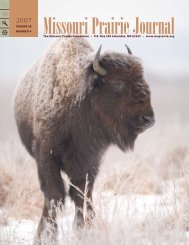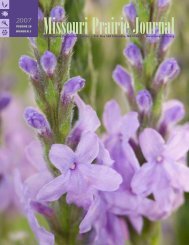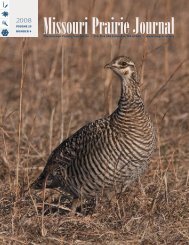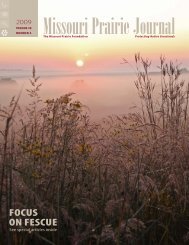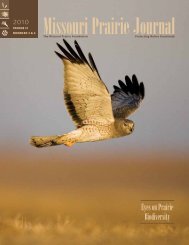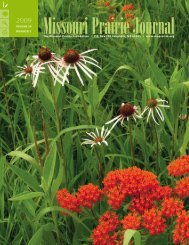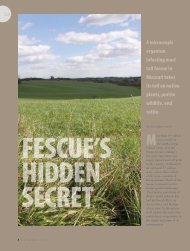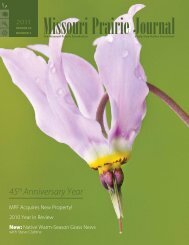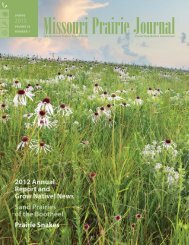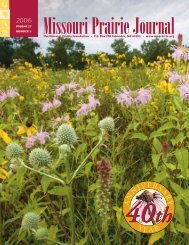Fall & Winter 2012: Volume 33, Numbers 3 & 4 - Missouri Prairie ...
Fall & Winter 2012: Volume 33, Numbers 3 & 4 - Missouri Prairie ...
Fall & Winter 2012: Volume 33, Numbers 3 & 4 - Missouri Prairie ...
Create successful ePaper yourself
Turn your PDF publications into a flip-book with our unique Google optimized e-Paper software.
“The purpose of the park<br />
is to maintain and restore<br />
JUSTIN JOHNSON<br />
<strong>Missouri</strong> Department of Conservation,<br />
and the <strong>Missouri</strong> Department of Natural<br />
Resources. According to William D.<br />
Blair, Jr., in his book Katharine Ordway,<br />
The Lady Who Saved the <strong>Prairie</strong>s, “the<br />
<strong>Missouri</strong> effort was capped in 1978–79,<br />
after the Bicentennial, by the acquisition<br />
of land for a 2,000-acre <strong>Missouri</strong> <strong>Prairie</strong><br />
State Park.”<br />
On June 3, 1980, the <strong>Missouri</strong><br />
Department of Natural Resources<br />
received the title to 1,520 acres<br />
acquired at $719,000 from The Nature<br />
Conservancy for the development of<br />
<strong>Prairie</strong> State Park. The land was 91<br />
percent original prairie—nine percent<br />
had previously been plowed. Of the<br />
original prairie, 59 percent had been<br />
grazed and 41 percent had been hayed.<br />
Thirty years ago, on June 27, 1982, the<br />
park was dedicated, and then Governor<br />
Christopher Bond proclaimed <strong>Prairie</strong><br />
Day in <strong>Missouri</strong>, “to praise those preservation<br />
and conservation organizations<br />
and individuals who have worked so<br />
hard to protect <strong>Missouri</strong> prairie.”<br />
From the moment the master plan<br />
for <strong>Prairie</strong> State Park was written in<br />
1979 to the present, <strong>Missouri</strong> State<br />
Parks has kept its mission in focus. The<br />
master plan stated the following: “The<br />
purpose of the park is to maintain and<br />
restore the native tallgrass prairie ecosystem<br />
as it was in the 1840s when the<br />
first permanent settlers came to Barton<br />
County, and to interpret this heritage<br />
for the people of <strong>Missouri</strong>.” It goes on<br />
to say “the objectives of <strong>Prairie</strong> State<br />
Park are twofold: Restoration and preservation<br />
of the original native prairie<br />
environment and provision of public<br />
enjoyment, understanding, and appreciation<br />
of the prairie” and “All planning<br />
and development will focus on creating<br />
a feeling and perception of prairie landscape<br />
character as it was prior to settlement.”<br />
Every plan that has been written<br />
and every decision that has been made<br />
has gone through this prism of maintaining,<br />
restoring, and interpreting the<br />
tallgrass prairie.<br />
The park has grown dramatically<br />
over the years from its original size of<br />
the native tallgrass prairie<br />
ecosystem as it was in the<br />
1840s when the first permanent<br />
settlers came to Barton<br />
County, and to interpret<br />
this heritage for the people<br />
of <strong>Missouri</strong>.”<br />
— <strong>Prairie</strong> State Park Master Plan<br />
When the first 1,520 acres of <strong>Prairie</strong> State<br />
Park were purchased in 1982, the land<br />
was 91 percent original prairie and nine<br />
percent had previously been plowed.<br />
Currently the park is 3,942 acres, with 81<br />
percent original prairie. Regal Tallgrass<br />
<strong>Prairie</strong> (3,646 acres of the park) was designated<br />
a State Natural Area in 2008.<br />
NOPPADOL PAOTHONG/MDC<br />
Vol. <strong>33</strong> Nos. 3 & 4 <strong>Missouri</strong> <strong>Prairie</strong> Journal 19




